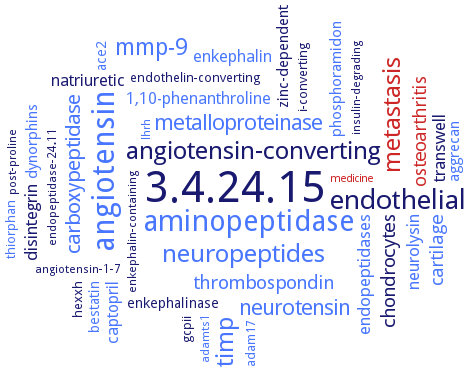Please wait a moment until all data is loaded. This message will disappear when all data is loaded.
Please wait a moment until the data is sorted. This message will disappear when the data is sorted.
E469R/R498T
-
site-directed mutagenesis of the substrate recognition residues leads to a swap of substrate specificity from thimet oligopeptidase to neurolysin, EC 3.4.24.16, the mutant cleaves neurolysin sites, overview
H495N/E469R/R498T
-
site-directed mutagenesis of the substrate recognition residues leads to a swap of substrate specificity from thimet oligopeptidase to neurolysin, EC 3.4.24.16, the mutant cleaves neurolysin sites, overview
H600A
-
the mutation affects both Km and kcat, the mutant shows changes in the pH-profile, overview
M490R/E469R/R498T
-
site-directed mutagenesis of the substrate recognition residues leads to a swap of substrate specificity from thimet oligopeptidase to neurolysin, EC 3.4.24.16, the mutant cleaves neurolysin sites, overview
M490R/H495N/E469R
-
site-directed mutagenesis of the substrate recognition residues leads to a swap of substrate specificity from thimet oligopeptidase to neurolysin, EC 3.4.24.16, the mutant cleaves TOP and neurolysin sites, overview
M490R/H495N/R498T
-
site-directed mutagenesis of the substrate recognition residues leads to a swap of substrate specificity from thimet oligopeptidase to neurolysin, EC 3.4.24.16, the mutant cleaves TOP and neurolysin sites, overview
E502Q
-
inactive mutant enzyme
A607G
-
site-directed mutagenesis, the mutation does not affect the overall fold of the protein, the mutant shows altered substrate specificity and kinetics with fluorogenic peptide substrates compared to the wild-type enzyme
C246S/C248S/C253S
site-directed mutagenesis, the mutations abolish the DTT and H2O2 effects on rTOP activity. The triple-mutated rTOP is not affected by DTT
D159A
-
similar to wild-type regarding enzymatic activity, secondary structure, calcium sensitivity and immunoreactivity
D93A
-
similar to wild-type regarding enzymatic activity, secondary structure, calcium sensitivity and immunoreactivity. Reduced ability to associate with the plasma membrane
D93A/D153A
-
similar to wild-type regarding enzymatic activity, secondary structure, calcium sensitivity and immunoreactivity. Reduced ability to associate with the plasma membrane
E502A
-
complete loss of enzymatic activity
G599A
-
decrease in the activity towards the 7-methoxycoumarin-4-acetyl-Pro-Leu-Gly-Pro-Lys-dinitrophenol and 7-methoxycoumarin-Leu-Glu-Asn-Lys-Pro-Arg-Arg-Pro-Lys(Dnp)-OH substrates, with little effect or in activity towards 7-methoxycoumarin-4-acetyl-[Ala7, Lys(dinitrophenol)9]-bradykinin
G603A
-
increase in preference for the five-residue 7-methoxycoumarin-4-acetyl-Pro-Leu-Gly-Pro-Lys-dinitrophenol substrate and, to a lesser extent, for the 10-residue 7-methoxycoumarin-Leu-Glu-Asn-Lys-Pro-Arg-Arg-Pro-Lys(Dnp)-OH substrate
G603A/G604A
-
increase in preference for the five-residue 7-methoxycoumarin-4-acetyl-Pro-Leu-Gly-Pro-Lys-dinitrophenol substrate and, to a lesser extent, for the 10-residue 7-methoxycoumarin-Leu-Glu-Asn-Lys-Pro-Arg-Arg-Pro-Lys(Dnp)-OH substrate
G603P
-
decrease in catalytic activity towards all substrates tested
G604A
-
decrease in the activity towards the 7-methoxycoumarin-4-acetyl-Pro-Leu-Gly-Pro-Lys-dinitrophenol and 7-methoxycoumarin-Leu-Glu-Asn-Lys-Pro-Arg-Arg-Pro-Lys(Dnp)-OH substrates, with little effect or in activity towards 7-methoxycoumarin-4-acetyl-[Ala7, Lys(dinitrophenol)9]-bradykinin
G611A
-
decrease in the activity towards the 7-methoxycoumarin-4-acetyl-Pro-Leu-Gly-Pro-Lys-dinitrophenol and 7-methoxycoumarin-Leu-Glu-Asn-Lys-Pro-Arg-Arg-Pro-Lys(Dnp)-OH substrates, with little effect or in activity towards 7-methoxycoumarin-4-acetyl-[Ala7, Lys(dinitrophenol)9]-bradykinin
H473A
-
complete loss of enzymatic activity
H474A
-
complete loss of enzymatic activity
H477A
-
complete loss of enzymatic activity
Y605A
-
site-directed mutagenesis, the mutation does not affect the overall fold of the protein, TOP Y605A is inhibited less efficiently by JA-2, the mutant shows altered substrate specificity and kinetics with fluorogenic peptide substrates compared to the wild-type enzyme
Y605F/Y612F
-
marked decrease in catalytic activity, but neither Y605 nor Y612 is necessary for hydrolysis of 7-methoxycoumarin-4-acetyl-[Ala7, Lys(dinitrophenol)9]-bradykinin
Y605F

-
site-directed mutagenesis, the mutation does not affect the overall fold of the protein, the mutant shows altered substrate specificity and kinetics with fluorogenic peptide substrates compared to the wild-type enzyme
Y605F
-
considerable decrease in catalytic activity
Y612F

the ratio of turnover-number to Km-value is 0.2% of the wild-type ratio. The Ki-value for N-[1-(RS)-carboxy-3-phenylpropyl]-Ala-Ala-Tyr-p-aminobenzoate is 2fold higher than the wild-type value
Y612F
-
marked decrease in catalytic activity
additional information

generation of enzyme knockout mice, phenotype, detailed overview. Wild-type and THOP1-/- mice demonstrate similar basal nociceptive sensibility in the hot plate test. Analysis of a potential depressive-like phenotype of THOP1-/-. THOP1-/- animals seem to have an impairment in their memory retention process
additional information
-
generation of enzyme knockout mice, phenotype, detailed overview. Wild-type and THOP1-/- mice demonstrate similar basal nociceptive sensibility in the hot plate test. Analysis of a potential depressive-like phenotype of THOP1-/-. THOP1-/- animals seem to have an impairment in their memory retention process
-




 results (
results ( results (
results ( top
top






